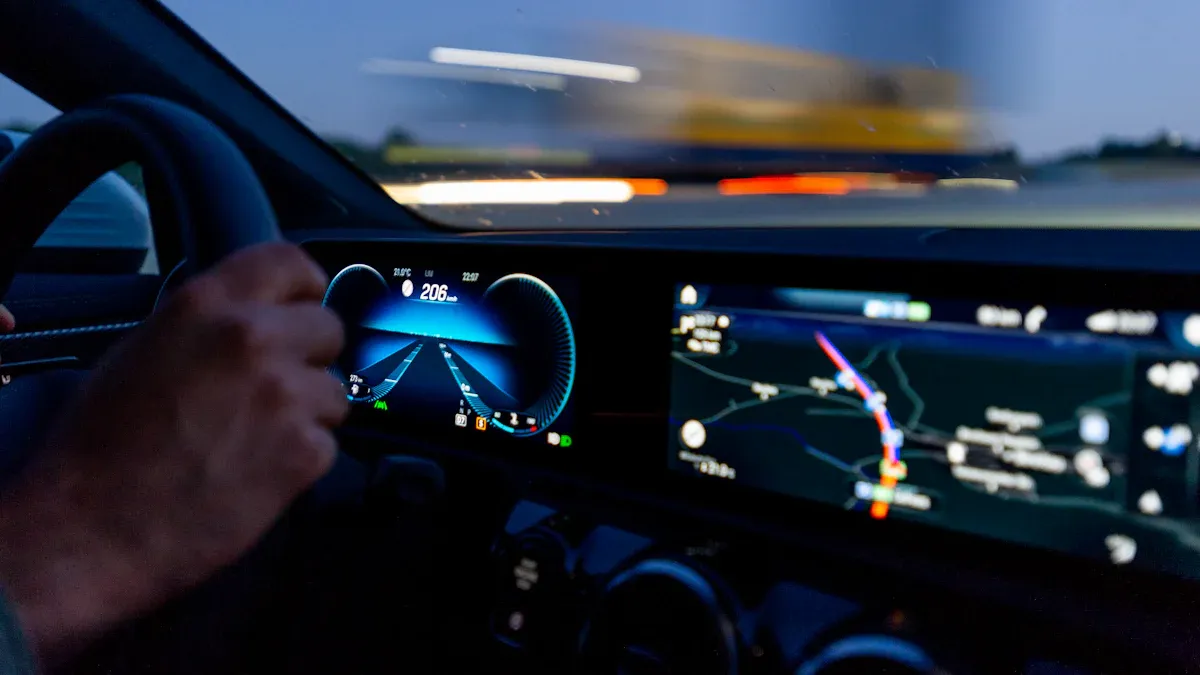How Safety MCUs Improve Autonomous Driving Reliability

Safety microcontrollers in autonomous driving play a crucial role in making self-driving cars safer and more reliable. They continuously monitor and assess systems, addressing issues to ensure the vehicles remain secure. As autonomous driving technology advances, the importance of these safety microcontrollers increases. For instance, features such as adaptive cruise control and emergency braking rely heavily on them. In 2023, the market value for these features reached $0.62 billion and $0.73 billion, respectively. Safety microcontrollers in autonomous driving are essential because they enable vehicles to function properly even when problems arise, which is vital for enhancing the safety and effectiveness of self-driving cars.
Key Takeaways
Safety microcontrollers (MCUs) help make self-driving cars safer. They check systems and fix problems to keep cars secure.
MCUs follow strict rules like ISO 26262 for safety. They lower risks from failures in important tasks like braking or steering.
These microcontrollers work with real-time software to keep things running. This ensures key functions happen smoothly without stopping, which is very important.
Safety MCUs have fail-operational support, so cars stay safe even if something breaks. This helps prevent accidents.
As self-driving technology grows, more safety MCUs are needed. They meet safety rules and make self-driving cars more reliable.
What Are Safety Microcontrollers in Autonomous Driving?
Definition and Purpose
Safety microcontrollers, or MCUs, are special units made for vehicle safety. They follow strict rules like ISO 26262 to keep systems safe in advanced driver-assistance systems (ADAS). Their main job is to lower risks from system failures, especially in key tasks like braking, steering, and avoiding crashes.
These microcontrollers have smart features like error checks and hardware protections to stop safety problems. They also combine data from many sensors to make better decisions. By lowering CPU work and boosting system dependability, safety microcontrollers help ADAS and self-driving systems work smoothly.
Feature | Description |
|---|---|
Compliance | Follows ISO 26262 for safety in car systems. |
Purpose | Reduces dangers from system failures in key tasks. |
ASIL Levels | Supports ASIL D, the top safety level for critical systems. |
Development Support | Offers tools for building safety-focused applications. |
Role as SoC Companions
Safety microcontrollers work with system-on-chip (SoC) solutions in cars. They ensure critical systems keep working even if part of them fails. This is important for keeping ADAS safe and effective.
These microcontrollers help domain controllers by handling sensor inputs like cameras, LiDAR, and radar. They use this data to control parts like brakes, steering, and acceleration. For instance, they reduce the workload on domain controllers and make systems more reliable.
Role of Safety Microcontrollers | Complementary Functions |
|---|---|
Supports ASIL-D safety requirements | Lowers CPU work and boosts system performance. |
Improves system reliability | Keeps ADAS parts like cameras and radars running smoothly. |
Safety microcontrollers also manage systems like power windows, anti-lock brakes (ABS), and airbags. Their ability to handle many tasks makes them key for ADAS and self-driving cars.
Note: Safety microcontrollers are vital for keeping cars safe and working, even during unexpected problems.
Key Functions of Safety MCUs in ADAS

Supervising Actuator Commands
Safety MCUs help control important car functions like braking and steering. They check how actuators work to find problems, like wrong speed or torque. This stops unsafe actions caused by system issues.
For example, error checks and state management keep actuators working safely. They watch things like speed and temperature to make quick fixes. If a small part fails, the system can still work in a limited way.
Safety Mechanism | Description |
|---|---|
Finds problems in actuator performance. | |
State Transition Management | Keeps safety during changes in system states. |
Fault Tolerance and Error Recovery | Lets the system work even if a small part fails. |
Monitoring System Health
Safety MCUs check the health of key parts like sensors and actuators. They find problems early, helping fix them before they cause failures. This keeps advanced systems reliable and safe.
They process sensor data, combine information, and manage controls. For example, they use radar and cameras to spot issues. By merging data, they give a full picture of system health. This reduces downtime and keeps cars running safely.
Sensor Processing: Reads and studies data from car sensors.
Data Fusion: Merges data from different sources for better decisions.
Control Systems: Handles car actions based on sensor data.
Providing Emergency Responses
In emergencies, safety MCUs follow safety plans to lower risks. They help the car slow down or brake to protect people.
The ISO 26262 standard ensures safety in these cases. Safety MCUs use error checks and hardware tools to stay safe. If something breaks, they isolate the problem and keep key systems working. This makes the system more reliable.
Tip: Failure mode and effects analysis (FMEA) helps find weak spots in safety MCUs. It shows risks and fixes to improve emergency responses.
Supporting Real-Time Software Environments
Enable Independent Real-Time Software Environments
Safety MCUs help create real-time software setups in ADAS. These setups let important tasks run without interruptions. This means key functions like braking and steering stay safe. They are not affected by delays or failures in other systems.
Powerful microcontrollers, like the NXP MPC5561, handle complex signals. They process data from radar and cameras quickly. This helps with fast decisions, like spotting obstacles or staying in lanes. These microcontrollers also meet ASIL-D safety standards. This makes them very reliable for critical tasks.
Note: Real-time setups are crucial for keeping cars safe. They are especially important as ADAS features become more advanced.
Facilitate Seamless Operation of ADAS/AD Applications
Safety MCUs also help ADAS and self-driving systems work smoothly. They combine data from radar, LiDAR, and cameras. This gives a clear view of the car's surroundings. It helps with decisions like cruise control and emergency braking.
Microcontrollers, like Infineon's AURIX™ series, are very flexible. They work for simple or advanced driving systems. Their software, like AUTOSAR, works on many platforms. This makes them very useful for modern cars.
Feature | Description |
|---|---|
Runs safety tasks without interruptions. | |
Data Fusion | Combines sensor data for better decisions. |
Scalability | Works for both basic and advanced systems. |
Safety Standards | Meets ASIL-D for top-level safety. |
By supporting real-time setups and smooth integration, safety MCUs improve ADAS reliability. These improvements bring us closer to fully self-driving cars.
Advantages of Safety Microcontrollers in Autonomous Driving Over Alternatives
Scalability
Safety MCUs are very flexible and fit many uses. They work well in both simple and advanced ADAS and AD systems. For example, AURIX™ Safety MCUs are known for their top-level flexibility. They easily connect to different electronic control units (ECUs).
Scalability is important for today's cars. It lets car makers adjust performance for specific needs. These MCUs allow hardware and software changes, saving time and money. They also help systems work together better.
Feature | Description |
|---|---|
Essential Role of Safety MCUs | Key part of FUSA for ADAS/AD, including controllers and sensors. |
Critical Functions of Safety MCUs | Manage commands, handle emergencies, check health, and support real-time tasks. |
Advantages of AURIX™ Safety MCUs | Top scalability, wide software options, and fail-operational ability. |
Tip: Scalability helps safety MCUs grow with new ADAS and AD tech. This makes them a smart choice for future cars.
Comprehensive Software Portfolio
Safety MCUs come with strong software tools, like AUTOSAR support. This makes them reliable for many uses in ADAS and AD systems. For instance, Infineon’s tech ensures safe ASIL-D processing. It also reduces CPU work and improves system dependability.
These microcontrollers meet ISO 26262:2018 rules up to ASIL-D. They protect against random errors and speed up safety app development. Pre-made software libraries make setup easier and more reliable.
Feature | Description |
|---|---|
Scalability | Excellent flexibility for different uses |
AUTOSAR Portfolio | Strong support for AUTOSAR standards |
Safety Software | Full safety software tools for dependability |
Fail-operational | Handles fail-operational tasks effectively |
Fail-Operational Support
Fail-operational support is a big benefit of safety MCUs. If a system fails, these microcontrollers keep the car running safely for a short time. This prevents dangerous situations, like losing control.
Fail-operational systems use backups to stay functional during problems. Safety MCUs use two separate systems (channel A and channel B). This lowers the chance of both failing at once, keeping one system working.
Note: Using different backup systems makes failures even less likely. Their differences make them less prone to the same issues.
By keeping systems running during failures, safety MCUs improve ADAS and AD reliability. This feature is key for making cars more autonomous and safer.
Hardware Separation
Special hardware keeps safety strong.
Dedicated safety MCUs are made to keep ADAS and self-driving systems safe. Unlike regular chips, these microcontrollers follow strict safety rules like ISO 26262. They separate important safety tasks from other jobs. This keeps safety systems working even if something fails.
The ISO 26262 process checks these features with detailed tests like FMEDA. This test shows how safety MCUs handle random problems to stay reliable. By keeping safety tasks separate, they stop one problem from causing more issues. This is very important for parts like radar, LiDAR, and ECUs.
These microcontrollers also check for errors and monitor systems in real time. This helps with features like adaptive cruise control and emergency braking. They make sure the car reacts quickly to dangers, improving safety.
Tip: Safety MCUs use hardware separation to reduce risks. This makes them very important for modern ADAS and self-driving systems.
Safety Islands miss this key feature.
Safety islands, found in regular chips, don’t have the same hardware separation as safety MCUs. They offer basic safety but can’t fully separate critical tasks. This makes them less useful when systems need to keep working during failures.
Safety islands also don’t meet the high standards of ISO 26262. They skip detailed tests like FMEDA, which check how well they handle random problems. Without these features, systems like lane-keeping and blind spot detection may not work reliably.
Modern ADAS and self-driving systems need chips that handle tough tasks while staying safe. Safety MCUs are better than safety islands because they separate tasks and keep safety systems running during problems.
Note: For cars needing high safety, safety MCUs are better than safety islands.
Importance of Safety MCUs in Future Advanced Driver-Assistance Systems

Higher Levels of Autonomy
Highly autonomous cars need strong safety systems to avoid accidents. As cars move closer to full autonomy, safety MCUs become more important. They add backups to keep systems working during failures. This protects passengers and others on the road.
The need for advanced safety features is growing fast. In the U.S., AI-powered car systems caused at least 25 deaths and many injuries. Features like forward collision warnings show risks when drivers lose control. Safety MCUs solve these issues by keeping key systems running, even in tough situations.
Market trends show how vital safety MCUs are. In 2023, the ADAS market was worth $1.22 billion. By 2032, it may grow to $2.37 billion as electric and autonomous cars become more popular. These numbers highlight how safety MCUs shape the future of self-driving cars.
Note: Safety MCUs are crucial for making highly autonomous cars reliable. They ensure vehicles stay safe in all conditions.
Role in ADAS/AD Applications
Safety MCUs are key for managing complex systems in ADAS and self-driving cars. They process data from cameras, LiDAR, and radar to control brakes, steering, and acceleration. Their ability to handle many tasks makes systems work smoothly and reliably.
Modern cars depend on safety MCUs for parts like power windows, engines, anti-lock brakes (ABS), and airbags. In ADAS, they support features like adaptive cruise control and emergency braking. By combining sensor data, safety MCUs help cars make smart decisions and react to changing road conditions.
The rise of electric and self-driving cars shows why safety MCUs matter. They follow strict safety rules like ISO 26262 and use advanced error checks. Their strong design ensures ADAS and self-driving systems meet top safety standards. This leads to safer and smarter transportation.
Tip: Safety MCUs are essential for managing sensors and controls in ADAS. They help cars drive safely and efficiently.
Safety microcontrollers are key to making cars safer and more reliable. They check systems, fix problems, and keep cars safe in all situations. Companies like Ford and BMW use them to improve engines, emissions, and stability.
The car safety market is growing fast, with an 8% yearly increase expected in five years. As car technology improves, safety microcontrollers will stay important. They help meet strict rules and what buyers want. Their flexibility, backup support, and strong software make them essential for today’s car safety.
What is the difference between ADAS and Autonomous Driving?
ADAS helps drivers with tasks like braking and parking. It makes driving safer and easier. Autonomous Driving means cars drive themselves without human help. ADAS needs a driver, but Autonomous Driving does not.
Why are Safety MCUs important for ADAS?
Safety MCUs keep ADAS systems working safely. They check sensors, find problems, and use backups if something fails. They handle data from cameras and radars. This helps features like cruise control and emergency braking work well.
How do Safety MCUs support fail-operational capabilities?
Safety MCUs have backups to keep systems running during failures. If one part stops working, the backup takes over. This keeps important tasks like braking and steering working. It makes ADAS and self-driving systems more reliable.
What role do sensors play in ADAS?
Sensors like cameras, radar, and LiDAR gather data about the road. This helps ADAS features like lane-keeping and blind spot alerts. They use this data to make quick decisions, improving safety and driving.
How does scalability benefit Safety MCUs in modern vehicles?
Scalability lets Safety MCUs work in many car systems. They can handle simple tasks like parking or advanced ones like self-driving. This makes them useful for new car technologies as they grow.
See Also
Unveiling The Essential Automotive Features Of FREESCALE MCF5251CVM140
Enhancing Automotive Performance Using NXP Microcontrollers MC9S12 Series
Analyzing MC9S12DJ256MFUE Specs For Automotive Use Cases
RV1126 Drives AI Edge Computing Solutions For Robotics
SPC56 Microcontrollers Provide Simple Solutions For Engine Control
CALL US DIRECTLY
(+86)755-82724686
RM2508,BlockA,JiaheHuaqiangBuilding,ShenNanMiddleRd,Futian District,Shenzhen,518031,CN
www.keepboomingtech.com sales@keepboomingtech.com
